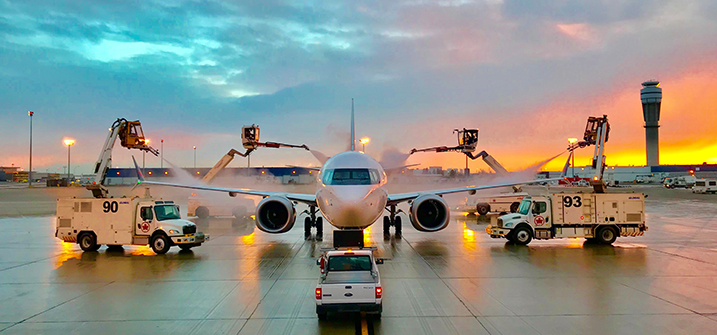
Everyone who travels in the winter, especially in Canada, is by now familiar with the captain’s message from the flight deck explaining that before takeoff, the aircraft must make a stop at the de-icing bay. But why is de-icing so important, and how is it done?
“No snow, ice or frost can adhere to the wings of an aircraft because it disrupts the aerodynamic flow over the wing. Air must smoothly flow over the wing to produce lift, which makes de-icing a key component of winter flying,“ explained Captain Douglas Morris, who flies our flagship Boeing 787 Dreamliner and publishes a monthly column in enRoute on various aviation topics.
In most of the major airports in Canada used by Air Canada, de-icing is handled by a separate company, but in Calgary, our own crews do the work.
A recent visit to the Alberta airport allowed a firsthand look at how the job gets done.
Geoff Nicholas is Air Canada’s De-ice Coach in Calgary and overseas the coaching and training of nearly 70 Air Canada employees who handle de-icing at the airport for all Air Canada flights.
He and his team know just how important their job is, and they are at the ready before the crack of dawn to ensure safe flight.
“The most critical aspect is to remove all the contamination before flight. It is exceptionally important that we get all the frost, snow and ice off the aircraft before the aircraft starts to take off,“ Nicholas said.
De-icing in Calgary can be done at the gate, usually for prop planes to clear the props for engine start up, but the majority of the work happens at a dedicated area where two aircraft can be cleaned at once. There are 14 de-icing trucks in Air Canada’s fleet in Calgary, including three modern and efficient Safeaero 220 single-operator vehicles.
“It is a purpose-built de-icing truck. It allows us to de-ice and drive at the same time. It also allows us to be much more efficient with our application of fluids on the aircraft,“ Nicholas said.
Air Canada’s crews are able to control the blended concentration of Type 1 used based on weather, allowing for optimization so they aren’t using more glycol than needed. In Calgary, the deicing area is cleaned after every few aircraft using a truck-based vacuum, allowing for a good portion of the de-icing fluid to be recycled at an on-site facility to be reused. This helps reduce the environmental footprint of the operation, a key goal for Air Canada.
There are two different types of fluid used on aircraft: Type 1 and Type 4.
“The passengers will see two different types of fluid that we use. The first one is Type 1, it’s the pink (sometimes orange) fluid. It is a heated fluid and we use that to remove all the ice and snow from the aircraft. The second fluid that you will see is green in colour. It’s more of a sealer. It provides a barrier between the aircraft surfaces and any ongoing precipitation like snow or freezing rain,“ he said.
The crews in Calgary handle every type of aircraft in the fleet, from the smallest turboprops to our largest Boeing 777, which is a favourite of Nicholas.
“It presents the biggest challenge, but at the same time it’s the most satisfying once it’s done,“ he said.
So next time you are seated in an aircraft at the de-icing bay, give the crew a wave because they are a vital part of safe flying in winter.
